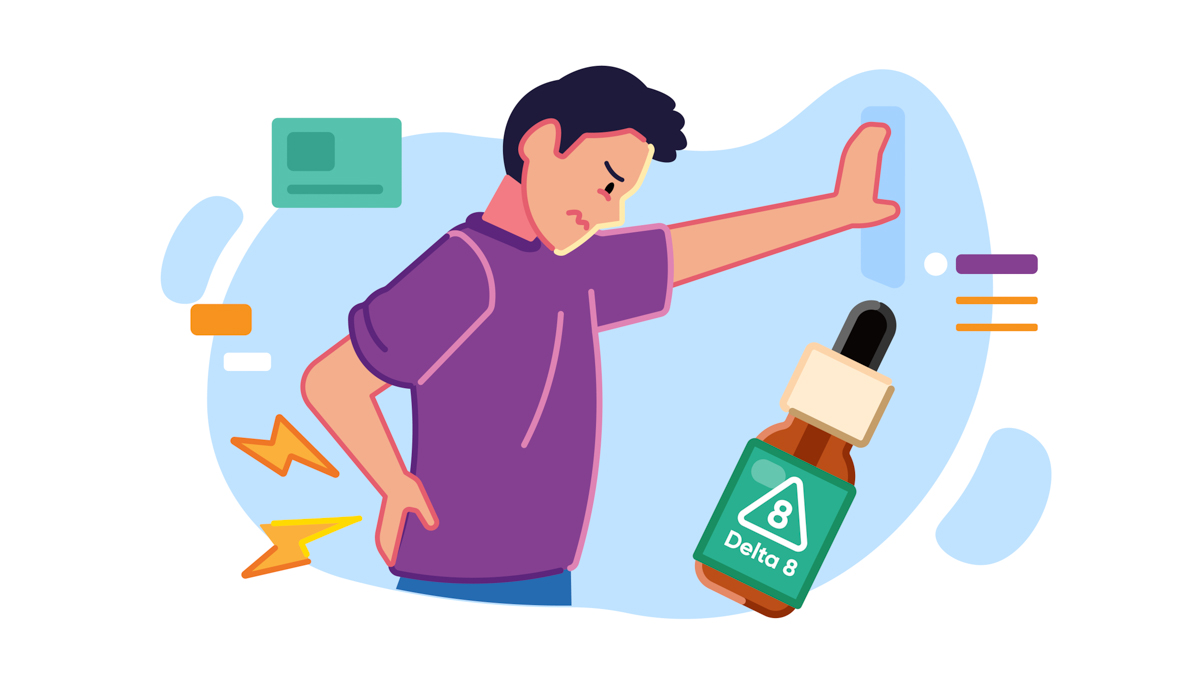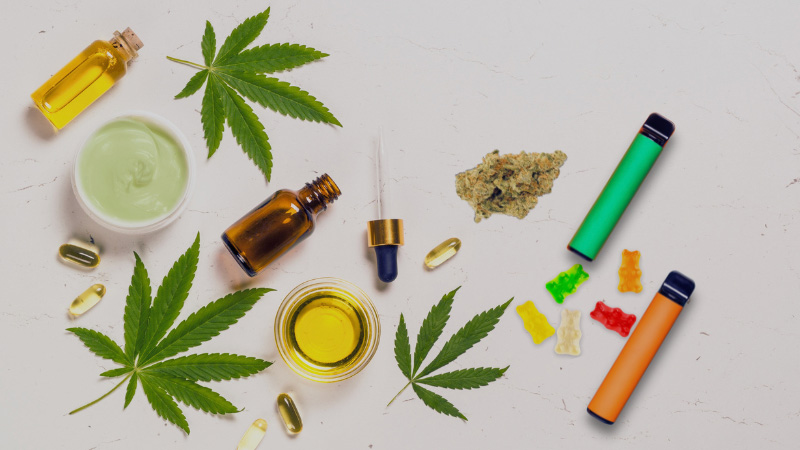Delta 8 for Pain Relief: Does It Work?

This article focuses on the benefits of delta-8 THC for pain. We highlight the anti-inflammatory and painkilling benefits of delta-8, compare them to delta-9 THC from marijuana, and explain how delta-8 and other cannabinoids interact with the endocannabinoid system to produce their therapeutic effects. After reading this article, you’ll learn everything there is to know about using delta-8 for pain; you’ll also gain the right toolset for selecting the best delta-8 products in terms of their quality and purity.
According to a 2021 national survey of delta-8 THC experiences in U.S. adults, 41% of delta-8 users take it for pain.
Cannabinoids are known for their remarkable anti-inflammatory and pain-killing benefits, but each isomer of THC produces unique effects that vary in intensity and duration.
Most people turning to delta-8 THC for pain claim they achieve similar relief but without the overwhelming cerebral stimulation associated with delta-9 THC from marijuana.
That’s because delta-8 THC has lower psychoactive potency than its more popular cousin.
In this article, we share everything there is to know about using delta-8 for pain. You’ll learn about the mechanisms governing its effects, interactions with other cannabinoids and terpenes, and potential side effects.
Delta-8 for Pain Management (Key Takeaways)
- Delta-8 THC reduces pain by curbing inflammation and mitigating pain signaling in the brain.
- The effects of delta-8 THC are mediated by the endocannabinoid system (ECS), which regulates essential functions such as pain perception, sleep, memory, mood, body temperature, immune function, appetite, etc.
- Delta-8 THC activates CB1 receptors in the brain and central nervous system (CNS). These are the same receptors that interact with delta-9 THC and induce the psychoactive buzz.
- Delta-8 THC is 50% as potent as delta-9 THC. The high is milder and comes with a lower incidence of unpleasant side effects like anxiety and paranoia.
- Not all effects of delta-8 THC for pain stem from its interaction with CB1 receptors. Delta-8 also activates the CB2 receptors, which control immune responses and inflammatory processes.
- When buying delta-8 products online, look for third-party lab reports that refer to the current batch. The delta-8 THC market is unregulated, and there’s a high risk of buying a contaminated and dangerous product if you don’t do your research.
What Is Delta-8 THC?
Before we get into explaining how delta-8 THC works for pain, let’s make sure you understand what it is and where it comes from.
Delta-8 THC is a minor cannabinoid, meaning that cannabis plants don’t synthesize it naturally in large quantities.
Instead, delta-8 THC forms as a byproduct of delta-9 THC’s degradation. When THC breaks down over time due to exposure to light and air (oxidation), most of it transforms into CBN — a mildly psychoactive, sedating cannabinoid (1).
Only a fraction of delta-9 THC turns into delta-8 THC, making direct extraction inefficient.
How Is Delta-8 THC Extracted?
Recent breakthroughs in extraction technologies have allowed manufacturers to obtain usable amounts of delta-8 from hemp.
They use specialized catalysts such as heptane with p-toluenesulfonic acid to convert CBD into delta-8 THC.
These chemicals must be completely removed from the final product, which raises concerns about their safety due to the lack of lab testing standards for delta-8 THC extracts.
Related Article: How Is Delta-8 THC Made?
How Is Delta-8 Different From Delta-9 THC?

Delta-8 and delta-9 THC have similar health benefits, including pain and inflammation management.
However, the strength of these effects varies between them due to a subtle difference in their chemical structures.
Delta-8 THC has a double atomic bond at the eighth carbon chain; meanwhile, delta-9 THC has this bond at the ninth chain (2).
This makes delta-8 THC about 50% as potent as delta-9 THC.
Delta-8 has a weaker affinity with the CB1 receptor in the brain and central nervous system. While it can get you high, the buzz isn’t as intense as the one created by delta-9 THC.
You’d need to double your delta-8 THC dose to achieve the same type of psychoactive effects as with high-THC cannabis.
Related: Delta-8 vs. Delta-9 vs. Delta-10
Why Do People Use Delta-8 THC?
Lower strength translates into a lower risk of unpleasant side effects. People who turn from delta-9 to delta-8 THC do so because delta-9 THC makes them feel anxious and paranoid.
Some cannabis users are highly reactive to the psychedelic nature of delta-9, meaning they don’t handle high doses well. Delta-8 THC helps them achieve the desired effects without the overwhelming layer.
People commonly use delta-8 THC for (3):
- Pain
- Inflammation
- Stress
- Anxiety
- Depression
- Sleep problems
- Loss of appetite
- Nausea
- Vomiting
- Loss of motivation
- Problems with focus (microdosing)
How Does Delta-8 THC Work for Pain?
Delta-8 THC uses two mechanisms to ease pain:
- It reduces inflammation, relieving itching, swelling, burning, and discomfort
- It dampens pain signals in the brain, making it more manageable
The effects of delta-8 THC on pain are mediated by the endocannabinoid system.
The Endocannabinoid System Explained
The endocannabinoid system (ECS) is a complex regulatory network that controls homeostasis (balance) between other systems and organs in the body.
The ECS regulates essential functions, such as memory, mood, stress responses, pain perception, immune function, neurogenesis, body temperature, appetite, sleep, fertility, etc (4).
It consists of endocannabinoids, cannabinoid receptors, and enzymes that break down the endocannabinoids.
The ECS has two types of cannabinoid receptors — CB1 and CB2 (5).
The CB1 receptors are mostly found in the brain and central nervous system and control motor function, memory, learning, mood, and pain signaling.
The CB2 receptors occur in the peripheral nervous, immune, and blood systems. They help regulate inflammation, immune response, pain, and metabolic processes.
Endocannabinoids are chemical messengers that bind to these receptors and send signals throughout the body to regulate the above processes.
Once used, enzymes break them down into metabolites and flushed over time.
How Delta-8 THC Interacts With the Endocannabinoid System to Reduce Pain
Delta-8 THC activates both CB1 and CB2 receptors.
Interacting with the former allows delta-8 THC to modulate pain signaling in the brain — temporarily increasing your pain threshold and reducing the intensity of physical discomfort (6).
Activating the latter causes the release of adenosine, which blocks proinflammatory cytokines and reduces inflammation (7).
That’s why delta-8 THC can be an effective remedy for managing the symptoms of autoimmune and neurological conditions.
Types of Delta-8 Products for Pain Relief

If you plan to use delta-8 for pain, knowing the different delivery methods and how they affect pain levels will help you choose the right product for your needs.
Here are the most popular forms of delta-8:
- Delta-8 vapes: these products are sold as ready-made vape pens or cartridges that you can attach to a standard 510 battery threading. They deliver high levels of delta-8 THC and are infused with strain-specific terpenes to modulate its health benefits. The effects of delta-8 vapes kick in after 3-5 minutes from your last puff and should last for up to 3 hours.
- Delta-8 flower: you can also buy CBD hemp flowers sprayed with delta-8 THC distillate if you’re looking for a well-balanced effect and enhanced benefits for pain relief. Just make sure your flowers come from organic hemp to avoid inhaling pesticides and heavy metals.
- Delta-8 tinctures: similar to CBD oil, delta-8 tinctures are taken under the tongue. You need to hold them there for about 60 seconds before you swallow, and the effects should take hold after 30-45 minutes, lasting up to 6 hours. Tinctures come with special droppers that make dosing more accurate and convenient.
- Delta-8 edibles: delta-8 gummies, honey sticks, and other treats are made with a predetermined dose of delta-8 THC per serving. They kick in with a slight delay because the delta-8 must be metabolized by the liver first. You may need to wait for up to 90 minutes to experience the psychoactive buzz. Edibles may hit you harder than other forms of delta-8 because they pass through the blood-brain barrier more effectively.
- Delta-8 topicals: although not as popular as the above formats, we may see more of such products in the future as the research on the topical use of delta-8 expands. Topical delta-8 products won’t make you feel high because your skin doesn’t have CB1 receptors, but they’ll provide localized relief from pain and other signs of discomfort.
Related: Delta 8 Gummies for Pain Relief
Delta-8 THC Dosage for Pain
The standard dosage range for delta-8 products ranges between 10–60 mg.
10 mg is enough to provide mild psychoactive effects and relief from everyday aches. For more severe pain, doses upwards of 40 mg should be able to ease your symptoms.
As with any psychoactive compound, the best way to dose delta-8 for pain is to start slowly. Take 10 mg of delta-8 for a few days and see how your body responds to it.
If you don’t feel less pain, increase the dose by another 5-10 mg and reevaluate the effects.
Tolerance to delta-8 THC increases twice as fast as to delta-9 THC. To prevent it from building up, use smaller doses more regularly or switch the terpene profiles of your product to “shock” the body with a new chemical formula.
Whenever you experience dizziness, sedation, confusion, or feel anxious after taking delta-8 for pain, you can either decrease the dose or add balancing cannabinoids like CBD or CBC to your routine.
Is Delta-8 or Delta-9 THC Better for Pain?
That depends on what type of pain you’ve got in mind.
When it comes to nerve pain, the stronger stimulation of CB1 receptors in the brain may prove more beneficial for patients, making delta-9 THC products more effective.
But if you suffer from inflammatory pain, then both cannabinoids go hand in hand.
People usually choose delta-8 over delta-9 THC for pain because it doesn’t induce the mental discomfort associated with high doses of delta-9.
Talk to your doctor if you plan to use delta-8 THC for pain relief. Doing so will help you find the optimal dosage, learn how to blend different cannabinoids to achieve stronger therapeutic effects, and avoid interactions between delta-8 and pharmaceutical medications.
Is Delta-8 or CBD Better for Pain?

I would ask a different question: why should you use delta-8 THC together with CBD for pain?
CBD makes your endocannabinoids more available to the body by signaling their increased production in the ECS and inhibiting enzymes that break them down (8).
This quality helps increase your natural resistance to pain and prevent hyperalgesia (oversensitivity to pain).
On top of that, CBD offers remarkable anti-inflammatory properties because it targets the same receptors in the ECS as delta-8 THC (9).
Together, delta-8 and CBD can be effective remedies for inflammatory pain. This unique synergy is referred to as the “entourage effect” and explains why whole-plant products are superior to purified compounds (10).
Related: Delta-8 THC vs. CBD
What Terpenes Work Best With Delta-8 THC for Pain?
Terpenes are another class of compounds that contribute to the entourage effect. Not only do they give cannabis plants their distinctive aromas and flavors, but they also modulate the health benefits of each strain.
Look for the following terpenes when buying delta-8 for pain relief:
- Myrcene: the most abundant terpene in cannabis. It enhances the potency of THC by increasing the permeability of the blood-brain barrier and strengthening its anti-inflammatory and analgesic effects. It also has relaxing properties that help ease tension in the muscles (11).
- Pinene: this terpene is also found in pine needles, rosemary, mint, and saffron. It doesn’t bind to cannabinoid receptors; instead, it targets opioid and GABA receptors. Pinene-rich strains may be effective for migraine and neuropathic pain (12).
- Linalool: the most concentrated terpene in lavender flowers, linalool can reduce inflammation and can block pain through central and peripheral mechanisms (13).
- Limonene: this terpene is common among citrus fruits and may offer pain relief by modulating TRP channel activity (14).
- Caryophyllene: also known as “the dietary cannabinoid,” beta-caryophyllene binds to cannabinoid receptors, enhancing their activity and boosting the therapeutic effects of major cannabinoids like THC and CBD (15).
- Humulene: you can find it in both cannabis and hops. Humulene has been proven to relieve inflammation when administered orally, by aerosol, or topically (16).
Final Verdict: Should You Use Delta-8 THC for Pain Management?
Although not as well researched as delta-9, delta-8 THC may provide significant relief from pain.
Delta-8 THC activates CB1 and CB2 receptors in the endocannabinoid system, making it useful for easing inflammation and dampening pain signals in the brain.
Since delta-8 is about 50% less potent than delta-9 THC, many people are turning to it to avoid anxiety and paranoia associated with the latter.
If you want to maximize the benefits of delta-8 for pain relief, combine it with the right terpenes, such as myrcene, linalool, caryophyllene, and humulene, and add some CBD to your routine.
This way, you’ll leverage the entourage effect in your product, maximizing the therapeutic potential of delta-8.
Sources:
- Arno Hazekamp, Justin T. Fischedick, Mónica Llano Díez, Andrea Lubbe, Renee L. Ruhaak, 3.24 – Chemistry of Cannabis. Editor(s): Hung-Wen (Ben) Liu, Lew Mander, Comprehensive Natural Products II, Elsevier, 2010, Pages 1033-1084.
- Tagen, M., & Klumpers, L. E. (2022). Review of delta-8-tetrahydrocannabinol (Δ8 -THC): Comparative pharmacology with Δ9 -THC. British journal of pharmacology, 179(15), 3915–3933 (2).
- Kruger, D. J., & Kruger, J. S. (2021). Consumer Experiences with Delta-8-THC: Medical Use, Pharmaceutical Substitution, and Comparisons with Delta-9-THC. Cannabis and cannabinoid research, 10.1089/can.2021.0124. Advance online publication (3).
- Mouslech, Z., & Valla, V. (2009). Endocannabinoid system: An overview of its potential in current medical practice. Neuro endocrinology letters, 30(2), 153–179.
- Zou, S., & Kumar, U. (2018). Cannabinoid Receptors and the Endocannabinoid System: Signaling and Function in the Central Nervous System. International journal of molecular sciences, 19(3), 833. https://doi.org/10.3390/ijms19030833
- Milligan, A. L., Szabo-Pardi, T. A., & Burton, M. D. (2020). Cannabinoid Receptor Type 1 and Its Role as an Analgesic: An Opioid Alternative? Journal of dual diagnosis, 16(1), 106–119 (6).
- Ashton, J. C., & Glass, M. (2007). The cannabinoid CB2 receptor as a target for inflammation-dependent neurodegeneration. Current neuropharmacology, 5(2), 73–80. https://doi.org/10.2174/157015907780866884
- Deutsch D. G. (2016). A Personal Retrospective: Elevating Anandamide (AEA) by Targeting Fatty Acid Amide Hydrolase (FAAH) and the Fatty Acid Binding Proteins (FABPs). Frontiers in pharmacology, 7, 370. https://doi.org/10.3389/fphar.2016.00370
- Atalay, S., Jarocka-Karpowicz, I., & Skrzydlewska, E. (2019). Antioxidative and Anti-Inflammatory Properties of Cannabidiol. Antioxidants (Basel, Switzerland), 9(1), 21. https://doi.org/10.3390/antiox9010021
- Russo E. B. (2011). Taming THC: potential cannabis synergy and phytocannabinoid-terpenoid entourage effects. British journal of pharmacology, 163(7), 1344–1364. https://doi.org/10.1111/j.1476-5381.2011.01238.x
- McDougall, J. J., & McKenna, M. K. (2022). Anti-Inflammatory and Analgesic Properties of the Cannabis Terpene Myrcene in Rat Adjuvant Monoarthritis. International journal of molecular sciences, 23(14), 7891 (11).
- Salehi, B., Upadhyay, S., Erdogan Orhan, I., Kumar Jugran, A., L D Jayaweera, S., A Dias, D., Sharopov, F., Taheri, Y., Martins, N., Baghalpour, N., Cho, W. C., & Sharifi-Rad, J. (2019). Therapeutic Potential of α- and β-Pinene: A Miracle Gift of Nature. Biomolecules, 9(11), 738. https://doi.org/10.3390/biom9110738
- Weston-Green, K., Clunas, H., & Jimenez Naranjo, C. (2021). A Review of the Potential Use of Pinene and Linalool as Terpene-Based Medicines for Brain Health: Discovering Novel Therapeutics in the Flavours and Fragrances of Cannabis. Frontiers in psychiatry, 12, 583211 (13).
- Araújo-Filho, H. G., Pereira, E. W. M., Rezende, M. M., Menezes, P. P., Araújo, A. A. S., Barreto, R. S. S., Martins, A. O. B. P. B., Albuquerque, T. R., Silva, B. A. F., Alcantara, I. S., Coutinho, H. D. M., Menezes, I. R. A., Quintans-Júnior, L. J., & Quintans, J. S. S. (2017). D-limonene exhibits superior antihyperalgesic effects in a β-cyclodextrin-complexed form in chronic musculoskeletal pain reducing Fos protein expression on spinal cord in mice. Neuroscience, 358, 158–169. https://doi.org/10.1016/j.neuroscience.2017.06.037
- Ceccarelli, I., Fiorenzani, P., Pessina, F., Pinassi, J., Aglianò, M., Miragliotta, V., & Aloisi, A. M. (2020). The CB2 Agonist β-Caryophyllene in Male and Female Rats Exposed to a Model of Persistent Inflammatory Pain. Frontiers in neuroscience, 14, 850. https://doi.org/10.3389/fnins.2020.00850
- Chaves, J. S., Leal, P. C., Pianowisky, L., & Calixto, J. B. (2008). Pharmacokinetics and tissue distribution of the sesquiterpene alpha-humulene in mice. Planta medica, 74(14), 1678–1683. https://doi.org/10.1055/s-0028-1088307